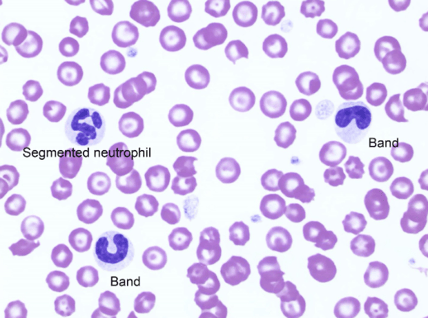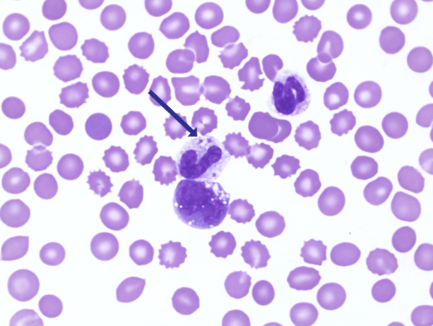CBC findings commonly seen in inflammatory states:
Inflammation can be associated with changes in the CBC. However, there are several reasons for CBC changes that are either physiological or stress associated. Inflammation can exist without triggering any CBC changes. Of course, sick animals can have more than one of these things happening at the same time. All these nuances can make interpretation of the leukogram (WBC total count and differential) challenging.
Examination of the neutrophil lineage provides the best cues to identify inflammation. In the most straightforward scenarios, the inflammatory process results in an increase in circulating mature or segmented neutrophils and an increase in immature neutrophils, bands. In these circumstances, band neutrophils often display toxic change, morphological changes in the cells that indicate they were released from the bone marrow at an accelerated rate. This is most often associated with infectious or inflammatory processes but can also be seen as part of a paraneoplastic response.
Microscopic appearance of segmented and band neutrophils:
The developmental stage of the neutrophil is determined by the degree of nuclear segmentation. Mature neutrophils have a visibly segmented nucleus (hence the term segmented neutrophil) that has coarse, condensed chromatin. Their cytoplasm is clear to very light blue/grey and does not contain any inclusions. Band neutrophils have a nucleus that is poorly segmented, most often shaped like a “U” or an “S” with little variation in the width of the nucleus (Figure 1). If the inflammatory draw is severe enough, earlier stages of the neutrophil lineage (e.g. metamyelocytes) can be seen in the blood smear.
Toxic change can include several features including cytoplasmic basophilia, Dohle bodies, and vacuolization. Dohle bodies are aggregates of endoplasmic reticulum that are normally removed during maturation of the cell in the bone marrow. When the neutrophils are kicked out early, they skip this process. The cytoplasm in general can be more basophilic, due to the increased amount of RNA, also associated with early exodus from the marrow (Figure 2).
Indistinct vacuolation can also be present and is thought to result from swelling of organelles. One or several of these features can be present, and they may be seen in some or all the neutrophils that are evaluated. The magnitude of the neutrophilia and left shift, as well as the severity of the toxic change, can provide information as to the duration and severity of the inflammation. In very acute and severe processes, there may be a decrease in neutrophil numbers (neutropenia) because the marrow has not had insufficient time to respond.
We often see a decrease in lymphocytes (lymphopenia) during states of illness in our patients. This results from lymphocytes redistribution that occurs secondary to glucocorticoids, and we tend to call this a “stress lymphopenia.” The magnitude of the lymphopenia is a prognostic indicator in several types of illnesses, so it is important to note.

Figure 1: Photo of a blood smear from a dog. Note the mature segmented neutrophil and the poorly lobulated nucleus of the two band neutrophils.
The increase of only mature segmented neutrophils can be seen in three different scenarios; chronic stress, physiological excitement, and inflammation that has been of sufficient duration to allow the bone marrow to perfectly match the demands of the process. During states of chronic stress, the production of glucocorticoids (eg cortisol), can cause decreased emigration of neutrophils from the blood into the tissues. The blood stream becomes like a highway congested with traffic, and the neutrophils are the cars. Physiological excitement can cause the release of catecholamines (epinephrine and normetanephrine), and this causes a redistribution of the neutrophils.

Figure 2: The arrow is indicated a Dohle body in a toxic band.
Elizabeth Spangler, DVM
Clinical Pathologist
Dr. Spangler earned her DVM from the University of California, completed a residency in Small Animal Internal Medicine and then a residency in Clinical Pathology. She was on the faculty at Auburn University for 17 years, and recently retired from that position. She is a writer/contributor for Ellie Diagnostics and is always supervised by at least one cat.